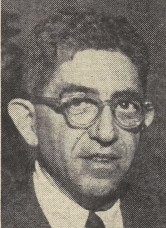Ernest Nagel facts for kids
Quick facts for kids
Ernest Nagel
|
|
|---|---|

Ernest Nagel (c. 1955)
|
|
| Born | November 16, 1901 Vágújhely, Austria-Hungary
|
| Died | September 20, 1985 (aged 83) |
| Education | CCNY (BSc, 1923) Columbia University (PhD, 1931) |
| Era | 20th-century philosophy |
| Region | Western philosophy |
| School | Analytic |
| Institutions | Columbia University |
|
Main interests
|
Philosophy of science |
|
Influences
|
|
|
Influenced
|
|
Ernest Nagel (born November 16, 1901 – died September 20, 1985) was an American philosopher of science. This means he studied the ideas and methods behind how science works. He is often seen as an important person in the logical positivist movement. This group of thinkers believed that knowledge comes from what we can observe and test.
His 1961 book, The Structure of Science, is a very important book in understanding the logic of how scientists explain things.
Contents
Life and Early Career
Ernest Nagel was born in a town called Nové Mesto nad Váhom. This town is now in Slovakia, but back then it was part of the Austro-Hungarian Empire. His family was Jewish.
When he was 10 years old, he moved to the United States. He became a U.S. citizen in 1919. He went to the City College of New York and earned his first degree in 1923.
Education and Columbia University
Nagel then went to Columbia University for his advanced studies. He earned his PhD in 1931. His main focus for his PhD was on the idea of measurement.
He spent almost his entire career teaching at Columbia University. He became a special professor there in 1955. He continued to teach until he retired in 1970. Even after retiring, he still taught some classes.
In 1977, he was chosen to be a member of the National Academy of Sciences. This is a very high honor for scientists and thinkers in the U.S.
Nagel's Work in Philosophy
Ernest Nagel was very interested in the philosophy of science. He explored how mathematical ideas, like geometry and probability, fit into science. He also looked at quantum mechanics, which is about how tiny particles behave.
He questioned how different scientific ideas could be connected or simplified. He was curious about how scientists use inductive reasoning. This is when you make general rules based on specific observations.
The Structure of Science
His most famous book, The Structure of Science (published in 1961), helped start the field of analytic philosophy of science. In this book, he explained the many ways scientists explain things in different fields. He didn't think all scientific laws or explanations could be easily combined into one big idea.
Nagel was one of the first to suggest a way to link terms from different sciences. He thought you could use "bridge laws" to connect them. This would mean you only needed to believe in the basic things from the simplest science.
He also believed that social sciences, like sociology or economics, are truly scientific. He thought they should use the same strict rules as natural sciences, like physics or chemistry.
Collaborations and Publications
Ernest Nagel wrote several important books with other thinkers. In 1934, he wrote An Introduction to Logic and the Scientific Method with his former teacher, Morris Raphael Cohen.
In 1958, he worked with James R. Newman to write Gödel's Proof. This short book helped explain Gödel's incompleteness theorems. These are complex ideas in mathematical logic that show limits to what math can prove.
Nagel also helped edit important journals. He was an editor for the Journal of Philosophy from 1939 to 1956. He also edited the Journal of Symbolic Logic from 1940 to 1946.
Public Views and Skepticism
Beyond his academic work, Ernest Nagel was a public intellectual. He was known for his skepticism. This means he liked to question things and look for evidence. He was especially skeptical about claims of the paranormal, which are things that seem to be beyond normal scientific understanding.
In 1976, he became one of the first supporters of the Committee for Skeptical Inquiry. This group works to promote scientific thinking and investigate unusual claims. He was recognized for his contributions to scientific skepticism. Ernest Nagel was also an atheist.
Memberships and Family
Ernest Nagel was a respected member of several important groups. He was elected to the American Philosophical Society in 1962. He also became a member of the American Academy of Arts and Sciences in 1981.
He passed away in New York. He had two sons: Alexander Nagel, who became a math professor, and Sidney Nagel, who became a physics professor.
Select Works
- On The Logic of Measurement (1930)
- An Introduction to Logic and Scientific Method (with M. R. Cohen, 1934)
- "The Formation of Modern Conceptions of Formal Logic in the Development of Geometry" (1939)
- Principles of the Theory of Probability (1939)
- "The Meaning of Reduction in the Natural Sciences" (1949)
- Sovereign Reason (1954)
- Logic without Metaphysics (1957)
- Gödel’s Proof (with J. R. Newman, 1958)
- The Structure of Science: Problems in the Logic of Scientific Explanation (1961, second ed. 1979)
- Observation and Theory in Science (with others, 1971)
- Teleology Revisited and Other Essays in the Philosophy and History of Science (1979)
See also
 In Spanish: Ernest Nagel para niños
In Spanish: Ernest Nagel para niños

